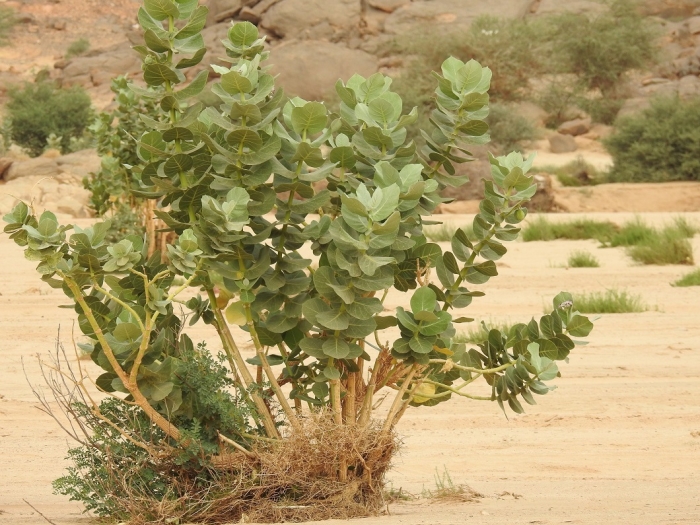Crown Flower
(Calotropis gigantea)
Crown Flower (Calotropis gigantea)
/
/

Karim Haddad
CC BY 4.0
Image By:
Karim Haddad
Recorded By:
Copyright:
CC BY 4.0
Copyright Notice:
Photo by: Karim Haddad | License Type: CC BY 4.0 | License URL: http://creativecommons.org/licenses/by/4.0/ | Rights Holder: Karim Haddad | Publisher: iNaturalist | Date Created: 2019-09-28T08:09:11-07:00 |




















Estimated Native Range
Summary
Calotropis gigantea, commonly known as the crown flower, is a large shrub or small tree that is deciduous in cooler climates and evergreen where temperatures remain high year-round. It is native to dry, tropical regions such as open woodlands and scrublands across South and Southeast Asia, including Cambodia, Vietnam, Bangladesh, Indonesia, Malaysia, Thailand, Sri Lanka, India, China, Pakistan, and Nepal. The plant typically grows up to 13 feet tall and wide, with a stout, upright form. It features clusters of waxy flowers, which are most commonly white or lavender, with a small, crown-like structure rising from the center, giving the plant its common name. The flowers are showy and often used in floral arrangements and religious offerings. The blooming season extends throughout the year in warmer climates.
The crown flower is valued for its ornamental flowers and is used in traditional medicine and for producing fibers. It is drought-tolerant and thrives in full sun with well-drained soil, making it suitable for xeriscaping and as an accent plant in dry gardens. However, it is potentially invasive in some regions outside its native range due to its ability to spread rapidly and outcompete native flora. Gardeners should check local regulations before planting. Calotropis gigantea contains compounds that are toxic if ingested and can cause skin irritation, so caution is advised when handling the plant.CC BY-SA 4.0
The crown flower is valued for its ornamental flowers and is used in traditional medicine and for producing fibers. It is drought-tolerant and thrives in full sun with well-drained soil, making it suitable for xeriscaping and as an accent plant in dry gardens. However, it is potentially invasive in some regions outside its native range due to its ability to spread rapidly and outcompete native flora. Gardeners should check local regulations before planting. Calotropis gigantea contains compounds that are toxic if ingested and can cause skin irritation, so caution is advised when handling the plant.CC BY-SA 4.0
Plant Description
- Plant Type: Shrub
- Height: 6-8 feet
- Width: 5-6 feet
- Growth Rate: Rapid
- Flower Color: Pink, Purple, White
- Flowering Season: Spring, Summer, Fall
- Leaf Retention: Evergreen
Growth Requirements
- Sun: Full Sun, Part Shade
- Water: Medium
- Drainage: Medium
Common Uses
Butterfly Garden, Drought Tolerant, Low Maintenance, Potted Plant
Natural Habitat
Dry, tropical regions such as open woodlands and scrublands
Other Names
Common Names: Swallow Wort , Bowstring Hemp , Crownplant , Giant Milkweed , Giant Milkwood , Madar
Scientific Names: Calotropis gigantea , Asclepias argentata , Asclepias gigantea , Calotropis gigantea , Calotropis gigantea , Calotropis gigantea , Madorius giganteus , Periploca chinensis , Periploca cochinchinensis , Streptocaulon cochinchinense
GBIF Accepted Name: